The Gili Islands have become a trendy destination for travelers who think Bali is now too “mainstream.” And while each of the islands has their own merits, based on what you’re looking for, Gili Air is often the happy medium of the three. This guide details how to best spend 3 days on Gili Air, with recommended activities and need-to-know information.
Jump to:
- Overview of the Gili Islands
- Getting to Gili Air
- Things to Know Before Visiting Gili Air
- How to Spend 3 Days on Gili Air
- Day 1: Getting the Lay of the Land
- Day 2: See the Underwater Side of Gili Air
- Day 3: Gili Above Water: Biking, Yoga, and Shopping
Overview of the Gili Islands
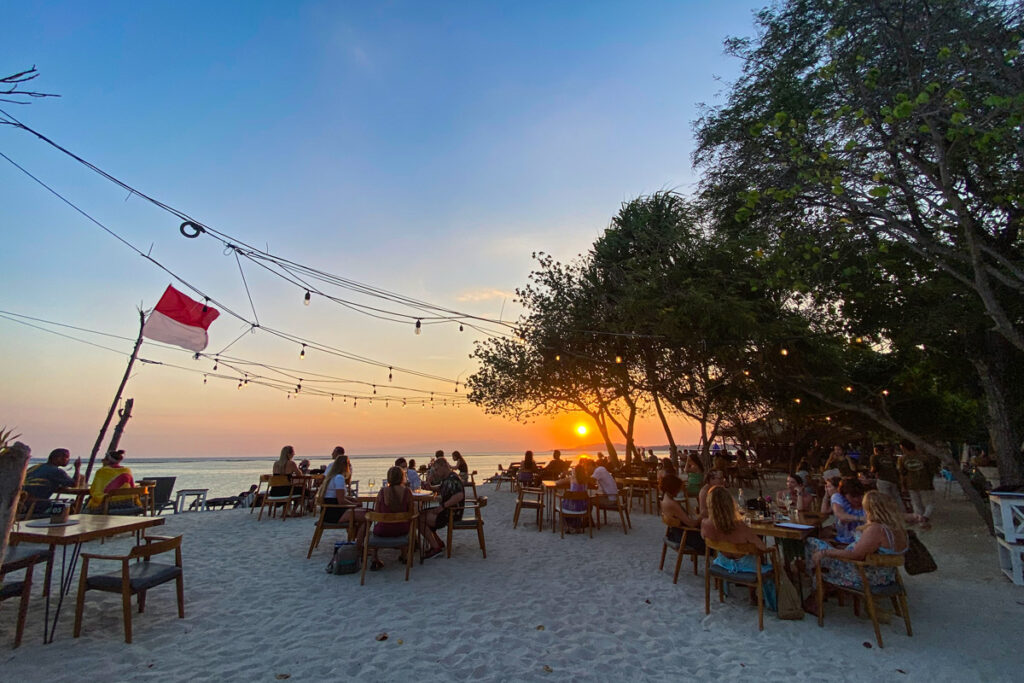
The Gili Islands, a string of three serene spits of land in the Lombok Strait, are a popular getaway for those looking to escape the crowds of Bali. While the Gilis have certainly exploded in popularity over the past decade, relative to how sleepy they used to be, they still provide a taste of the simple island life that feels worlds away from the traffic jams of Ubud or Denpasar.
Surprisingly, the history of the Gili Islands is brief, having only been permanently settled in the 1970s. Backpackers started arriving in the 1980s, but tourism really exploded in the 2000s, with the start of fast boat operations from neighboring Bali.
Three islands comprise the Gili archipelago:
- Gili Trawangan: the largest of the islands, and the most populated. Affectionately known as Gili T, it’s considered the “party” island, with a reputation that attracts the more hedonistic traveler in search of a good time.
- Gili Meno: the smallest island, it is also the quietest. There are less amenities and nightlife, which often appeals to honeymooners and those looking for a more secluded escape.
- Gili Air: if Gili T is too party-focused and Gili Meno is too quiet, Goldilocks would consider Gili Air “just right”. It has a decent amount of laid-back beach bars, but also plenty of solitude. If you’re looking for a sunset cocktail without the all-night party, Gili Air is a safe bet.
Getting to Gili Air
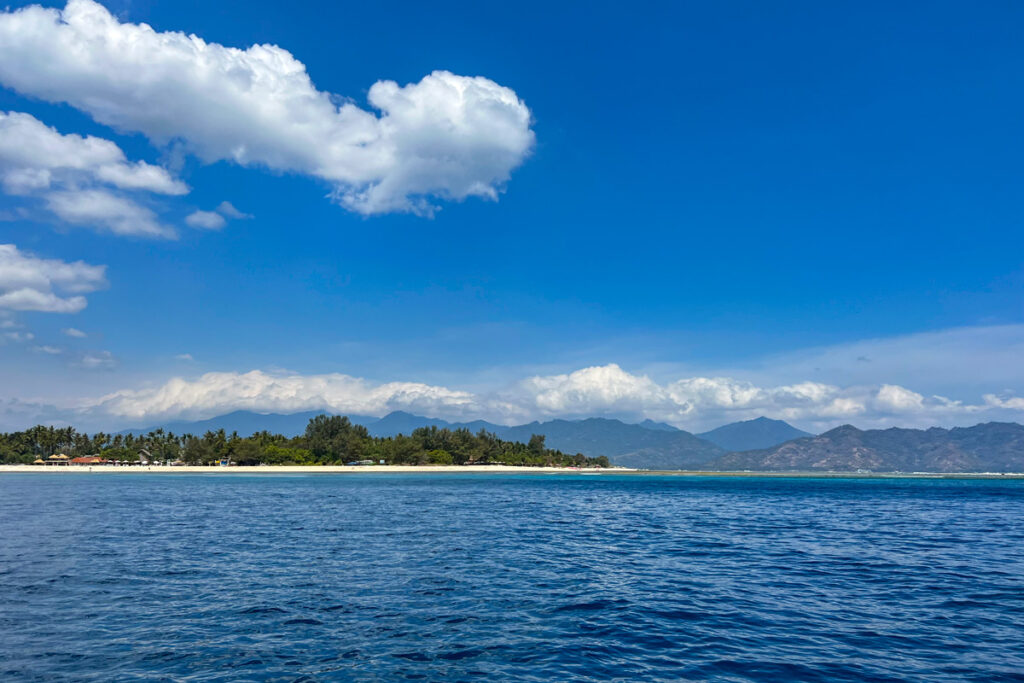
The Gili Islands lie off the coast of Lombok, and ferry service runs regularly between both Bali and Lombok. There are a multitude of fast boat operators, including Gili Getaway, Gili Gili Fast Boat, and Bluewater Express.
From Lombok, you can also catch a public ferry to save money if you choose. Ferries are often slow and crowded, but cost $1-2 USD, compared to the $35 USD you’ll pay for a fast boat.
- Arriving from Bali: boats depart from multiple locations along the eastern shore of Bali. Options include Serangan (near Nusa Dua, Kuta, and Seminyak), Padang Bai (central coast) and Amed (northern coast). The ride usually takes about 2.5 hours.
- Arriving from Lombok: boats depart from Senggigi, Bangsal Port, and T. Kodek. From here it’s a quick 30-minute jump to Gili Air.
Note: coming from Lombok might take more coordination, as some operators only run between Lombok and Gili T. From Gili T, you’ll need to catch an inter-island shuttle to Gili Air, another 20 minute ride.
Things to Know Before Visiting Gili Air
There are a few cultural notes to be aware and respectful of, when visiting Gili Air. These same notes apply to both Gili T and Gili Meno, as well.
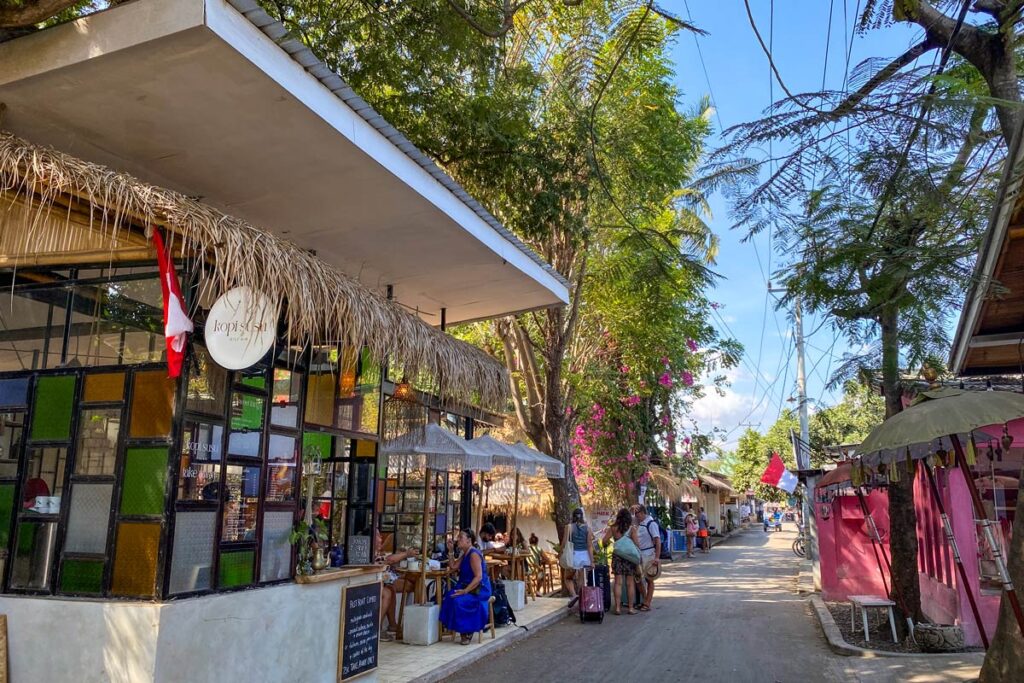
Expect to Pay a “Toll” to Both Arrive and Depart
Arriving on Gili Air, you’ll be greeted by officials requiring a fee of 10,000 IDR to enter the island. It’s considered a “harbor tax,” and while it feels like a scam, it’s just a fact of visiting Gili Air. They’ll require another 10,000 IDR when you leave the island. Plan to have the cash on you, to make it easy.
Getting Around the Island
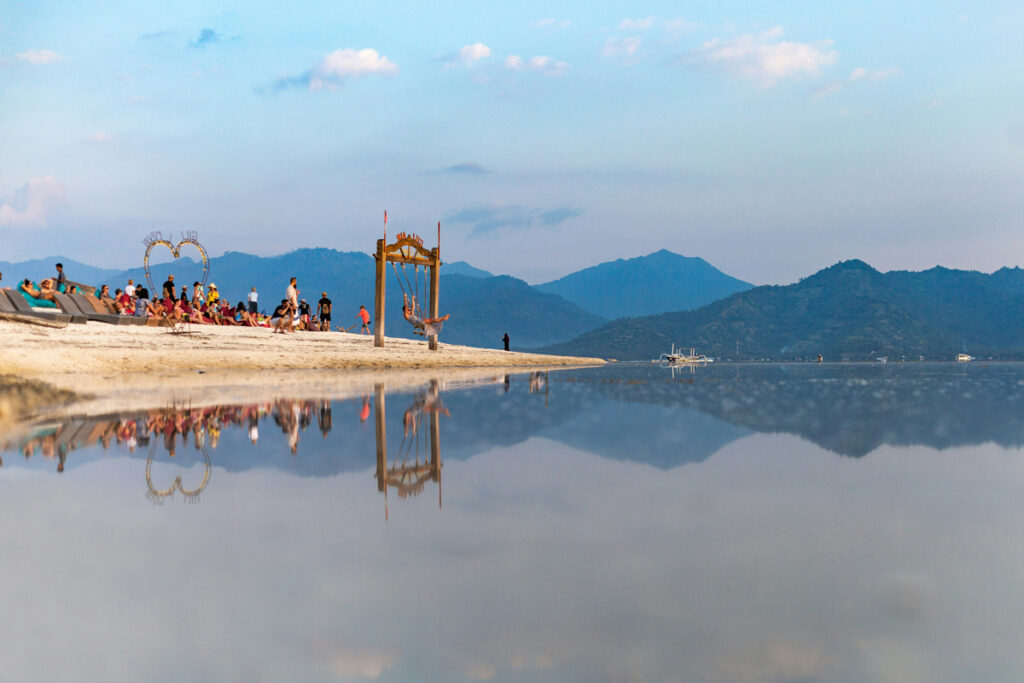
There are no vehicles on Gili Air. The “downtown” is an easy walk from the harbor, approximately 5 – 10 minutes even while pulling luggage behind you. Plan to walk when you explore the island, although you can also bike. In addition to a couple of bike rental shops, many of the local hotels offer rentals to their guests, as well.
Note: Traditionally, horse-drawn carts have also shuttled guests and luggage around the island. However, these horses have a long history of mistreatment. Efforts have recently been made to improve their care, but it’s still not recommended to support the Gili horse-cart industry.
Be Respectful of the Muslim Culture
Unlike Hindu Bali, the Gili Islands are Muslim, and it’s important to be respectful of your hosts’ culture while visiting.
Tourists are asked to cover up their bathing suits whenever they’re not on the beach. A tank top and shorts are fine; just don’t stroll through town in a bikini or swim trunks only.
Additionally, the local mosque will broadcast the call to prayer at regular intervals throughout the day, which can be heard on loudspeakers throughout the island. The first call of the day is at 5 a.m.: we strongly recommend bringing ear plugs, to avoid an early wakeup. Just don’t complain to locals about hearing the call, which comes across as a little disrespectful to their religion.
How to Spend 3 Days on Gili Air
Day 1: Getting the Lay of the Land
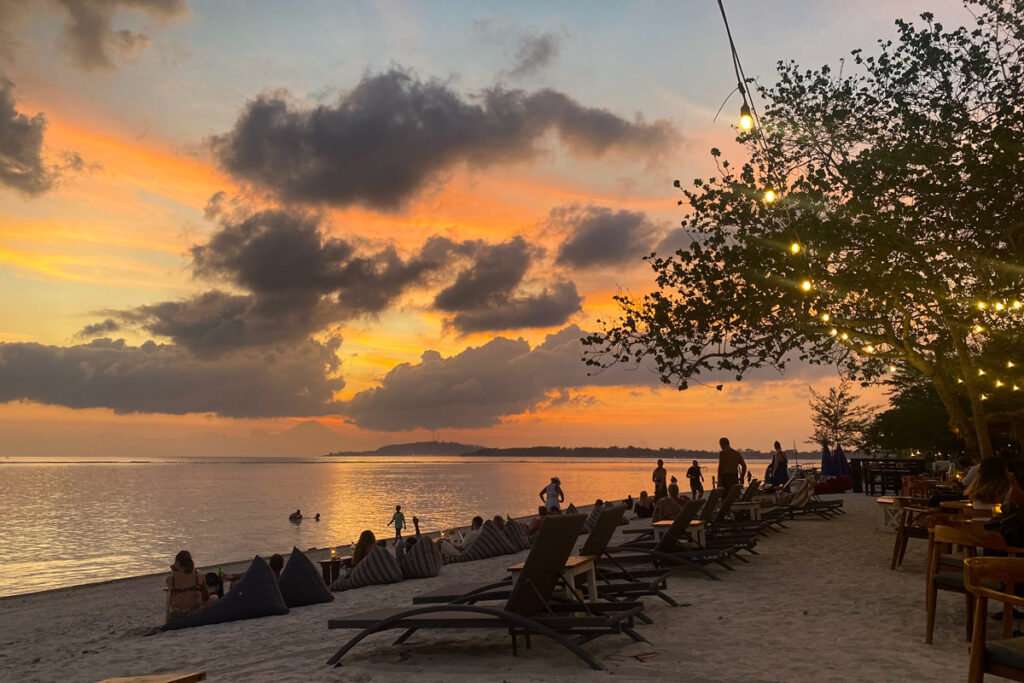
With most boat operators departing from Bali and Lombok in the morning, assume you’ll arrive on Gili Air around lunchtime. This leaves a half day to get the lay of the land after checking in to your hotel.
Stroll the main street that runs north/south, before heading to the beach to savor the first day of balmy island life.
An hour or two before sunset, head to the southwest coast of the island for happy hour with a view. There are a slew of beachside bars and restaurants overlooking the Lombok Strait, although Mowie’s is the most famous spot. You can post up with your toes in the sand, order a tropical cocktail, and watch the sky turn to fire as the sun sets behind Bali’s Mount Agung in the distance.
(If you’re looking for something to eat, Mowie’s has a surprisingly elevated menu, with everything from small bites to full dinner. The patatas bravas and scallop ceviche are excellent.)
Tip: If you happen to be here on a Monday night, Gili Lumbung offers live music every week. They’re just up the road from Mowie’s.
Day 2: See the Underwater Side of Gili Air
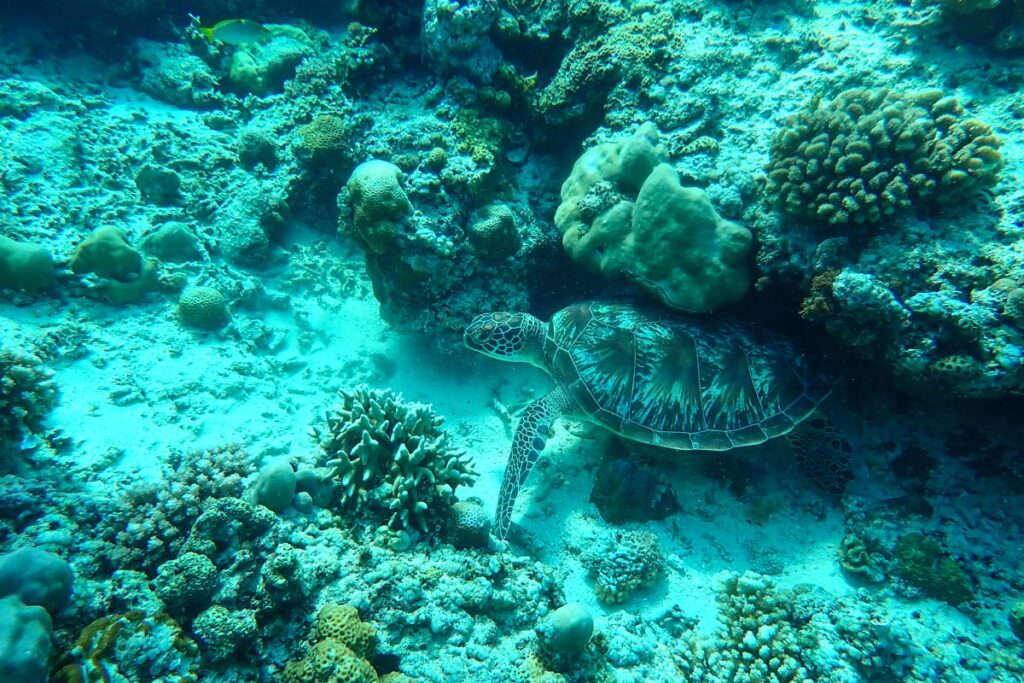
A longtime destination for divers, Gili Air offers a host of snorkeling and scuba opportunities. If you’re going to partake in an underwater adventure, this is a good day to do it.
For recreational snorkelers, there are vibrant tropical reefs just offshore. For scuba divers and the more adventurous snorkelers, Gili dive shops offer half-day and full-day excursions to neighboring islands. And if you’ve never gone scuba diving but want to learn, the dive shops offer certification courses too!
Where to Go Scuba Diving or Snorkeling (on a tour)
There are dive shops located throughout the island, although the biggest clusters are along the northwest, northeast, and southeast beaches. Besides scuba diving, most outfitters also offer snorkeling tours.
All operators are PADI certified, so you can’t go wrong. However, we personally used Blue Marlin Dive and found them very professional and a great outfitter. They offer a host of excursions, with everything from a quick morning outing to a full day trip. They’ll also help personalize your trip, recommending certain dive sites for your skill set and what you hope to see.
Where to Go Snorkeling (on your own)
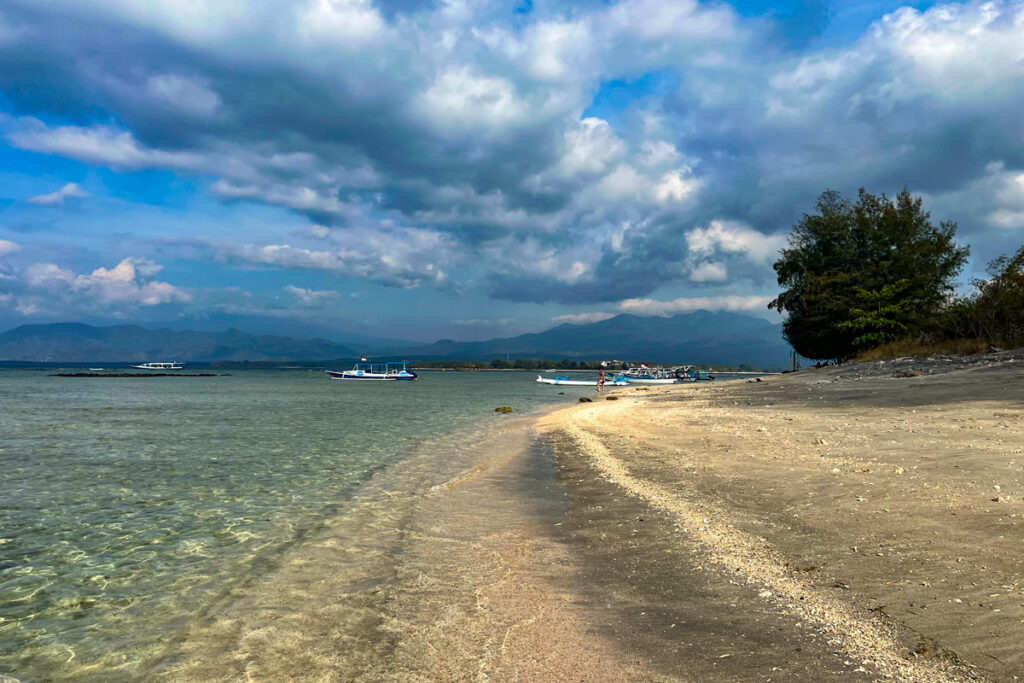
Gili Air is surrounded by coral reefs, so you’ll have a high likelihood of seeing sea life wherever you dive in. However, the most well-regarded reefs are along the eastern and northern shorelines, particularly the southeast coast.
The area around aptly-named Turtle Beach (directions) has a high prevalence of sea turtles, along with a multitude of colorful coral, tropical fish, and other marine life. You’ll need to wade through about 50 meters of sandy bottom and sea grass, before reaching the reef.
Snorkel Rental Info
If you need to rent snorkel gear, every dive shop (plus other local vendors) offer hourly and daily rentals. It’s no exaggeration to say you can barely walk down the beach without passing a rental advertisement. Choose your beach, and you should have no trouble finding a rental in the surrounding area.
Enjoy a Restorative Massage
After an active day in the sun, give your body some love with a restorative afternoon massage. There are numerous spas of varying price located throughout Gili Air, but all are extremely affordable relative to Western prices. You can choose from a series of massage styles (traditional Balinese, deep tissue, etc.) and select add-ons like aloe vera or aromatherapy to enhance the experience.
The more reasonably priced spots run about $8-9 USD for a 1-hour massage, or you can splurge at a place like Slow Spa for “luxury” (for a whopping $24 USD).
Tip: although walk-ins are welcome, the more popular spas do fill up during the high season. We recommend making an appointment ahead of time, if you have your heart set on a particular spot.
Day 3: Gili Above Water: Biking, Yoga, and Shopping
If yesterday was Gili Air by water, make today Gili Air by land.
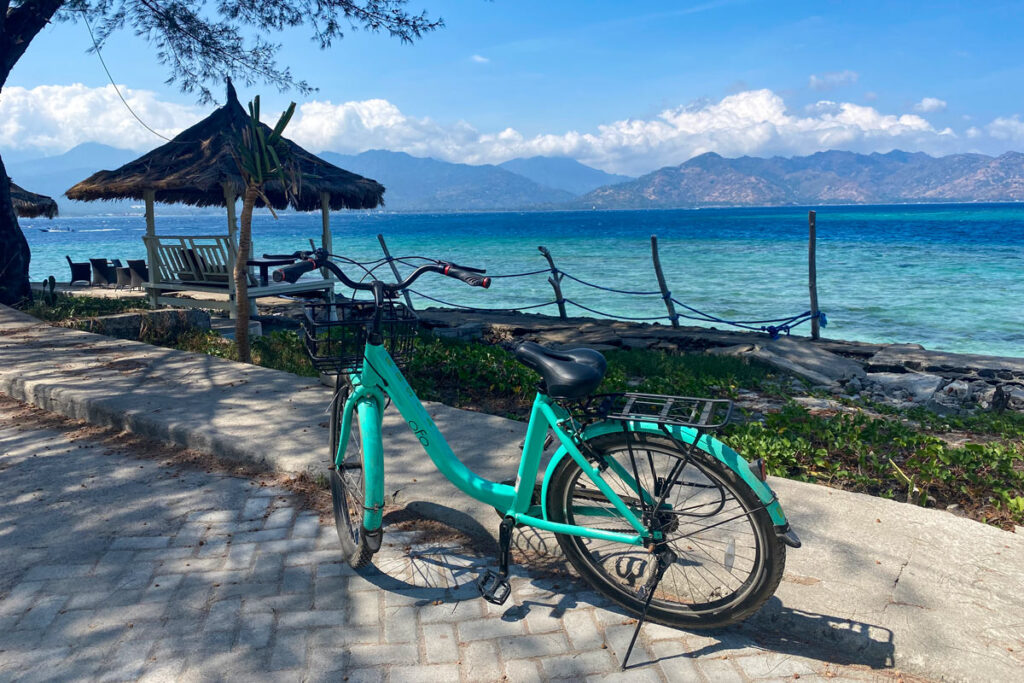
Morning Yoga
Start your morning with an energizing yoga class, to get a taste of the abundant wellness culture that permeates Bali and the Gilis. Many hotels offer daily classes, but you can also drop in to one of the local studios — Flowers and Fire and H20 Yoga are favorites.
Bike the Island

After breakfast, grab some bikes to explore the island before the worst heat of the day arrives. If your hotel doesn’t already offer rentals, you can pick some up at either Rent Bike Gili’s or Dalek’s on the south side of the island, Granat in the northwest, or Nelli in the northeast.
While you can reasonably cycle the length of the island in 10 – 15 minutes, it’s still a fun way to see the back streets and other areas you may not have seen on foot.
Tip: Biking is also a great time to visit Gili Coffee Roasters, a truly first-rate coffee shop. Tucked along a secluded dirt road in the interior of the island, Gili Coffee Roasters operates out of an expansive open-air thatched storefront. It’s not the easiest location to get to on foot, but the coffee is worth it and makes a great respite during a bike around the island. Beyond the regular offerings, you can also try gula aren, a traditional iced coffee drink with organic palm sugar syrup, milk, and cinnamon.
Once you’ve returned your bikes, make the most of your final afternoon on Gili Air, revisiting an old favorite or perhaps discovering a new beach you haven’t lounged on yet.
Shopping on Gili Air
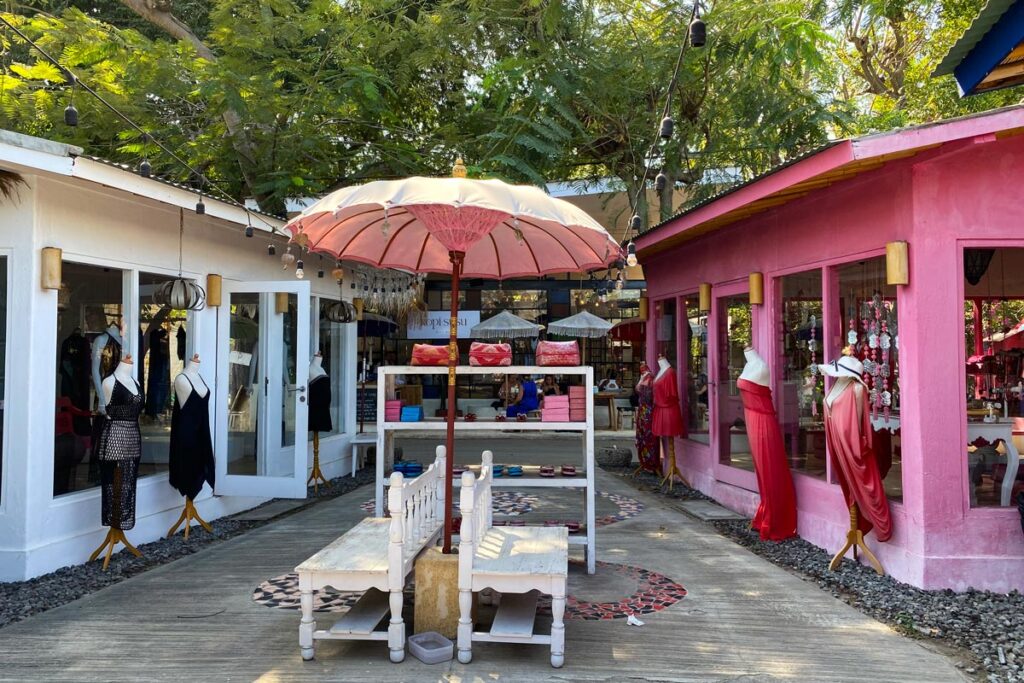
If you want to grab some souvenirs for friends and family back home, this is also a good time to pop into some of the local boutiques. The majority of stores sell the type of wares you’d expect from a hip, slightly bohemian tropical destination: gauzy beachwear, boho jewelry, ocean-themed home goods, etc.
Lizzy Darling and Yin Jewelry for the Soul all have fun jewelry and accessories, Moju Boutique offers surf apparel and home goods, while the series of brightly-colored Rainbow Stores (located on the main Jalan Mojo road in the heart of town) are great for women’s clothing.
On your last evening on Gili Air, head to one of the restaurants or beach bars along the western shore and savor one final sunset on this balmy island paradise.
Looking for more Gili Air recommendations? Check out our guides to the island’s best restaurants and best beaches, ranked by activity.
